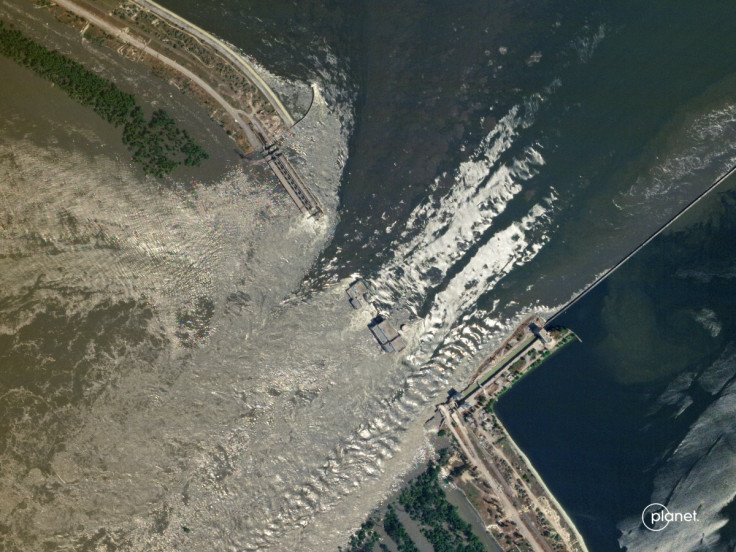Drained Kakhovka dam reservoir reveals skulls of WW2 soldiers
One of the skulls even had a helmet similar to the ones used by Hitler's soldiers

The breach of the Nova Kakhovka dam has not only flooded cities and forced people to flee but has also unearthed the horrific remains of World War II.
The emptied reservoir along the Dnipro River in Ukraine has revealed the skulls of soldiers who fought in the war. Videos from the emptied reservoir have made it to social media platforms and have gone viral after skulls with helmets were seen jutting out of the reservoir bed. However, the videos have not been verified yet.
One of the skulls even had a helmet similar to the ones used by Hitler's soldiers, per a report in Reuters. The German and Soviet armies had fought a brutal battle in the region during World War II.
During the Battle of the Dnipro, fought in Soviet Ukraine in 1943, millions of Red Army and German soldiers were killed or injured where the reservoir stands today.
"The losses of Soviet troops ranged from 30,000 to 60,000 people. The losses of German and Romanian troops were up to 20,000 people. So, in theory this video showing the helmet and skull could be linked to those events," Andrii Solonets, a historian at the National Museum of the History of Ukraine in the Second World War told The Guardian.
The Ukrainian divers have also been able to find parts of an S-300 missile near the southern city of Zaporizhzhia. It was first spotted by a local during a morning stroll.
The S-300 is a Soviet-era missile and was used by both countries. There has been no clarification as to whether it was Russia or Ukraine that launched the recovered missile.
Here is an extended version of the above video showing the skulls of Kakhovka reservoir.
— gary (@gporter812) June 12, 2023
If Ukraine did anything, it was to remind a people how their ancestors had to rid the land of Nazis and reignited a patriotic passion with blowing the dam and releasing the waters to uncover pic.twitter.com/qjng78r9GX
"Ammunition, in particular, even from the time of the Second World War, is found in the areas of the Kakhovsky Reservoir," said Ukraine's Ministry of Internal Affairs. The ministry has asked civilians to stay away from the receding reservoir, stating that the water is contaminated.
The reservoir had 18 cubic kilometres (4.3 cubic miles) of water before it was destroyed last week. It was one of Europe's largest reservoirs, and its destruction could prove catastrophic. Even though both sides blame each other for blowing up the dam, U.S. intelligence reports have claimed that the dam was under Russian control when it was destroyed.
🇺🇦🇺🇦🇺🇦🇺🇦🇺🇦UKRAINE🇺🇦🇺🇦🇺🇦🇺🇦🇺🇦
— HERCULES (@77HERCULES77) June 13, 2023
Due to the Dam Explosion and Recent Wash Out with Flooding…
World War 2 Skulls have been Washing Up in the Kherson region. pic.twitter.com/ta7wKymKwS
It is not just the flooding that has been a cause of concern. The presence of unexploded ordnance and Russian shelling has also become a threat to civilians.
This is not the first time that the remains of soldiers who fought in the Second World War have been discovered in some part of the world. In 2017, a construction crew found the remains of at least 21 World War II era Soviet soldiers in eastern Germany.
The remains of the Red Army soldiers were found in the town of Seelow, 70 kilometres (43 miles) east of Berlin, during the construction of a cycle path. The soldiers probably died during the last days of the war, in the final battles for Berlin between the Soviets and Nazi Germany.
In May 1945, Berlin was a war zone. Everyday life in the capital of Hitler's Third Reich had broken down. The streets were bombed out, there was no gas or electricity, and there was a daily fight for food. At night, sirens howled to signal bomb attacks, driving citizens into shelters.
The Allied forces had intensified their aerial bombardment so much that most of the city lay in ruins. The Red Army was approaching from the east; around 2.5 million Soviet soldiers and 6,250 tanks were closing in on Hitler.
On May 2, 1945, Berlin capitulated. Five days later, Germany signed an unconditional surrender at Allied headquarters in Reims, France, to take effect the following day, ending the Second World War in Europe. Some 33,000 Soviet and Polish soldiers, and about 12,000 Wehrmacht ones, were killed around Seelow.
© Copyright IBTimes 2025. All rights reserved.






















